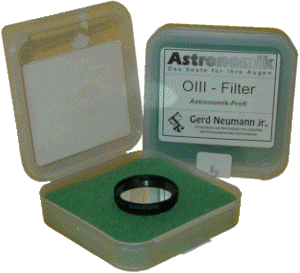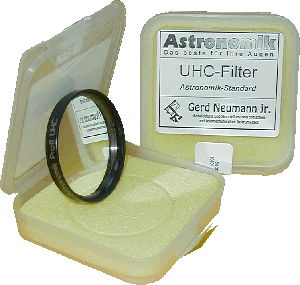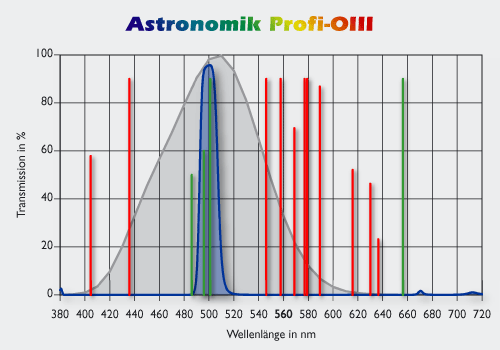Night Sky Filters
Interferential Filters
Modern technology gives us many instruments to fight light pollution and, in any case, to obtain the best from our equipment.
Interferential filters are one of these instruments.

How they work? Using the physical principle of interference, they select a very precise and narrow band to transmit, while all the other wavelengths are stopped so that you can observe a planetary nebula with a real dark background also from a light polluted sky.
There are many brand of interferential filter, personally I choose Astronomik UHC and OIII filters for a very good price/performances ratio.
I tested these two filters during an observation session at Monte Generoso Observatory on Swiss Alps on May 13, 2003. During that night the Moon was 2 days before full moon, the sky was clear (after a thunderstorm) and there was not much light pollution from the Pianura Padana.
The telescope is a 61-cm Ritchey-Chrétien f/8 with a TeleVue 40-mm eyepiece.
I point the telescope toward M57, the Ring Nebula is visible but with low contrast due to the glare of the Moon, then I mount the UHC filter on the eyepiece and ... the nebula switches on! It seems to have a light bulb behind the nebula, the field became very dark and the nebula very bright with a very high contrast, the vision was amazing! Than, I put the OIII filter. The vision is even better with a very dark background, the stars are dimmed very much but their colors are not so ... friendly: sometimes seeing a magenta-pink star is not very comfortable. I change again to UHC filter to check the color of the stars: at first sight, it seems the same with or without filter, but with a deep observation I note that the color is not just the same but in any case it is very “natural”. I have seen a the Ring Nebula like never before.

My second target is the Dumbell Nebulae M27. With UHC filter it appears at very high contrast with a lot of particular: the difference between UHC and "no filter" is stronger than for M57. I do not remember such a spectacular vision of the nebula. Then I mount the OIII filter. Wow! The vision improved again. A big and detailed nebula is visible and a lot of details came into view. Breathtaking!
On the market there are a lot of interferential filters but they are not all the same. I decided to buy them from Astronomik not because it is the only European manufacturer, but because the transmission band of these filters is very narrow so the cut-off of artificial light is very good and the transmission in the selected band is the highest on the market.
I bought them on line from AstroShop , a German dealer of Astronomik (but you can find them also from Adirondack Video Astronomy) so that the shipping cost are lower and given that Germany is in the EC I did not pay for custom duties.
In less than a week, Eric Sven-Vestig, the manager of AstroShop, sent me the filters.
Why they work
To understand the physics behind a nebular filter, I have to remember the emission theories of nebulae. As you well know the chemical composition of an emission nebula is about 90% Hydrogen and 10% Helium. Other elements are very rare. So, why a planetary nebula is visible in the Oxygen OIII line?

Quantum mechanics tells us that an atom emits light when an electron of this atom drops to a lower energetic level, for example H-alpha (Balmer H-alpha) line is emitted when the electron of an Hydrogen atom drops from level 3 to level 2. On the other side, an atom can rise to higher level if and only if a precise amount of energy is furnished. If the photon (the carrier of the energy) has less or more energy than this exact amount, the atom cannot receive any amount of energy.
Now, the composition of a nebula is 90% hydrogen so the most of photons emitted are in the Hydrogen light, so why they are more visible, or as much visible as, in the Oxygen light? Simply because every photon emitted by a hydrogen atom is absorbed by another hydrogen atom that rises its energetic level and then emits a photon that it will be absorbed by another atom and so on. Technically speaking, the nebula is “optically thick” for hydrogen light so that only few photons can exit nebula, all the others are emitted and absorbed inside the nebula. For the oxygen atom the physics is little different.

In emission nebulae (or HII region) and in planetary nebulae, the Oxygen is not at its natural state but is double ionized, but this is not the fact (that is the origin of the name OIII = oxygen doubly ionized). The reason of the brightness for these particular lines comes from the fact that the photons are emitted in a “forbidden” transition of levels. In other words, there are precise rule for quantum drop of levels, but in this case the electron pass from a level to another one without “observe” these rules. This is not a violation of law, but this transition has very few probability to happen. In any case, given that an atom can gain only well determined quantity of energy, an OIII photon cannot be captured by any other OIII atom because its energy is “forbidden”, so the photon goes out very quickly from the nebula. Technically speaking, we say that the nebula is “optically thin”.
The condition of the nebula: density, temperature, level of ionization, can bring Oxygen atom to its “forbidden” level. When the electron leaves this level, the atom emits a photon that cannot be absorbed by any other atom.
In a planetary nebula the hydrogen/oxygen mass ratio is around 108 but the hydrogen/oxygen light intensity ratio is around 1!
UBVRI Filters
On the market there are a lot of color filters, for RGB, for planetary observation, and so on, but it is rather difficult to find photometric filter.
One of the best producer is Schuler Astro Imaging. Its filters are normally used by the AAVSO. Therefore, New Millennium Observatory has Johnson-Cousins Bessell Design Photometric Filters. The full set of these filters, that should be able to produce very accurate photometric results, is available from Adirondack. Sincerely, at the present (September 2005) I have not yet used them.
Filter wheel
Astronomers work during the night and they love to work in darkness, but what doing if you need to change some configuration of your system during an observing session?
The solution is, obviously, automate, automate, automate!
Let me talk about the filter wheel.
I looked for any kind of this instrument, and I decided to buy a True Technology Custom Wheel. In my opinion this is the most flexible and versatile wheel of the world. It is absolutely light proof, motorized and it is very easy to change filters inside without dismount the wheel from the optical imaging train.
You can see some technical detail directly from True Technology or from Adirondack where I bought it in spring 2003.
Without touching the focuser or CCD camera, you can completely remove the internal wheel in a matter of seconds. The focus position and the CCD camera orientation are untouched, so that as soon as a filter is changed or cleaned, the internal wheel can be re-installed and you can continue imaging with a minimum of disturbance.
The Custom-Wheel has a female SCT thread on front and back, which is a 2” diameter. The 2” adapters have a clear internal aperture of 45-mm, and that coincides with the clear aperture of 2” filters.
